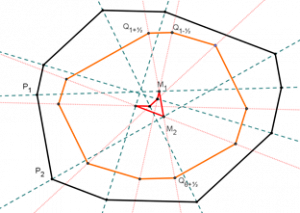The midlines of a CPOS polygon are the lines which are equidistant from opposite sides (so, they connect successive midpoints Mi and support the AE). Now, given a CPOS polygon P=P1P2…P2n, it is possible (see [1] for proof) to construct another CPOS polygon Q=Q1Q2…Q2n such that:
· The great diagonals of Q are the midlines of P;
· The sides of Q are parallel to the great diagonals of P.
In fact, given the polygon P, there is a 1-parameter family of such polygons Q, which we call the Dual Family of P.

The orange polygon Q is a member of the dual family of P.
Next applet allows you to play with a CPOS polygon P, and generates a dual polygon Q. You can move the slider α to see other members of the dual family.
This is a Java Applet created using GeoGebra from www.geogebra.org – it looks like you don’t have Java installed, please go to www.java.com
Things to note:
· Whenever Q is convex, the CSS of Q is the AE of P;
· The members of the dual family are equidistants of each other, and all have the same AE;
· Hence, there is a member of the dual family which is this very AE, traveled twice – set α to zero to see it!
Now, call N=N1+½N2+½…Nn+½ the AE of Q (where Ni+½ is on the midline parallel to PiPi+1). Here are some properties relating P directly to N:
· If the line joining Pi and Ni+½ intersects the segment Pi+nPi+n+1, then it divides the polygon P in two regions of the same area (proof in [1]);
· Moreover, in this case, since Ni+½ is on the midline, it will be the midpoint of the chord that such line determines inside P.

The chord through P1 and N1+½ splits areas equally!
[1] M. Craizer, R. Teixeira and M. Horta, “Parallel Opposite Sides Polygons”, preprint.